The Cambridge History of China. Vol. 06. Alien Regimes and Border States, 907-1368
Подождите немного. Документ загружается.

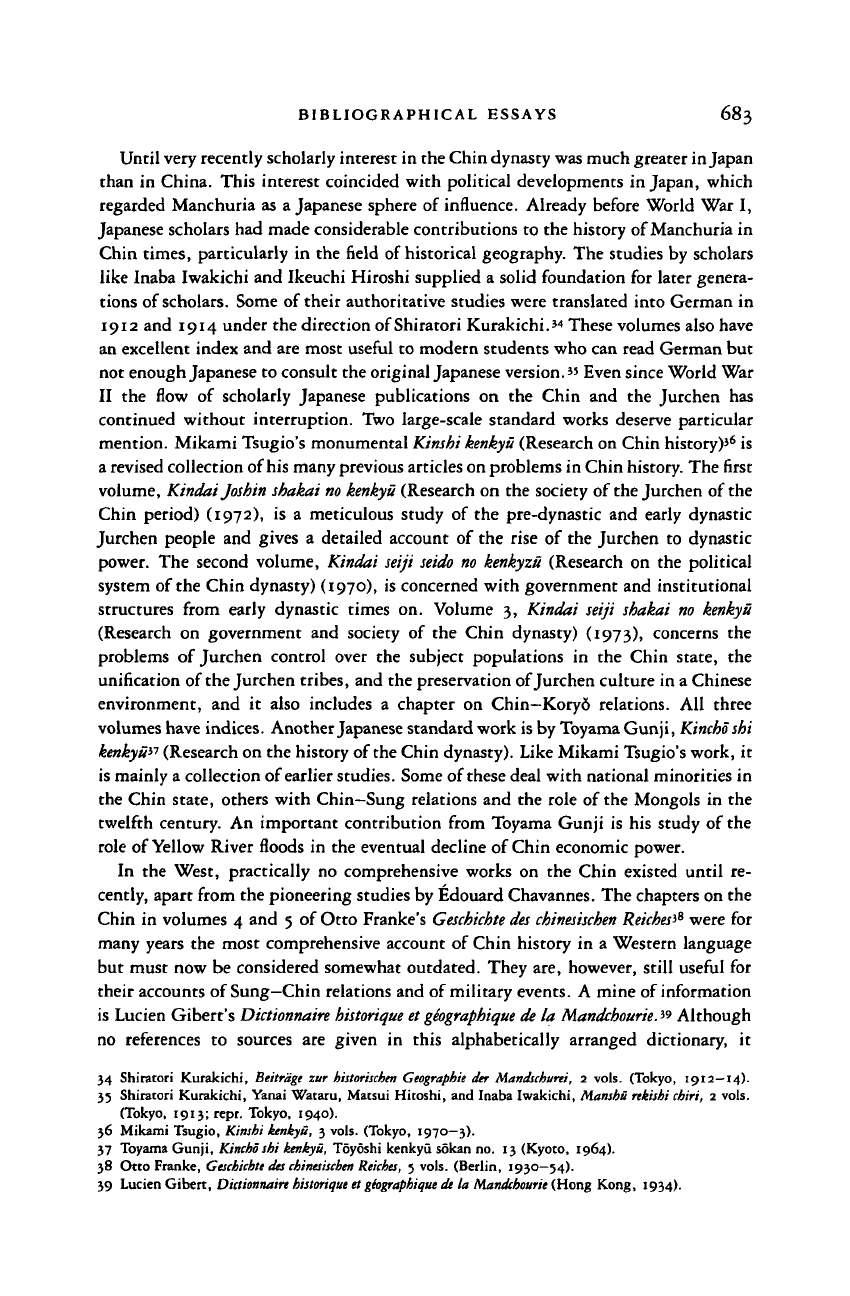
BIBLIOGRAPHICAL ESSAYS 683
Until very recently scholarly interest in the Chin dynasty was much greater in Japan
than in China. This interest coincided with political developments in Japan, which
regarded Manchuria as a Japanese sphere of influence. Already before World War I,
Japanese scholars had made considerable contributions to the history of Manchuria in
Chin times, particularly in the field of historical geography. The studies by scholars
like Inaba Iwakichi and Ikeuchi Hiroshi supplied a solid foundation for later genera-
tions of
scholars.
Some of their authoritative studies were translated into German in
1912 and 1914 under the direction of Shiratori Kurakichi.
M
These volumes also have
an excellent index and are most useful to modern students who can read German but
not enough Japanese to consult the original Japanese version.
35
Even since World War
II the flow of scholarly Japanese publications on the Chin and the Jurchen has
continued without interruption. Two large-scale standard works deserve particular
mention. Mikami Tsugio's monumental
Kinshi kenkyu
(Research on Chin history)
36
is
a revised collection of his many previous articles on problems in Chin history. The first
volume, Kindai
Joshin shakai no kenkyu
(Research on the society of the Jurchen of the
Chin period) (1972), is a meticulous study of the pre-dynastic and early dynastic
Jurchen people and gives a detailed account of the rise of the Jurchen to dynastic
power. The second volume, Kindai
seiji seido
no
kenkyzu
(Research on the political
system of the Chin dynasty) (1970), is concerned with government and institutional
structures from early dynastic times on. Volume 3, Kindai
seiji
shakai no
kenkyu
(Research on government and society of the Chin dynasty) (1973), concerns the
problems of Jurchen control over the subject populations in the Chin state, the
unification of the Jurchen tribes, and the preservation of Jurchen culture in a Chinese
environment, and it also includes a chapter on Chin—Kory6 relations. All three
volumes have indices. Another Japanese standard work is by Toyama Gunji,
Kinchoshi
kenkyiP
1
(Research on the history of
the
Chin dynasty). Like Mikami Tsugio's work, it
is mainly a collection of earlier
studies.
Some of these deal with national minorities in
the Chin state, others with Chin-Sung relations and the role of the Mongols in the
twelfth century. An important contribution from Toyama Gunji is his study of the
role of Yellow River floods in the eventual decline of Chin economic power.
In the West, practically no comprehensive works on the Chin existed until re-
cently, apart from the pioneering studies by Edouard Chavannes. The chapters on the
Chin in volumes 4 and 5 of Otto Franke's
Geschichte des chinesischen
Reiches^
8
were for
many years the most comprehensive account of Chin history in a Western language
but must now be considered somewhat outdated. They are, however, still useful for
their accounts of Sung-Chin relations and of military events. A mine of information
is Lucien Gibert's Dictionnaire
historique
et
geographique
de la Mandchourie.
39
Although
no references to sources are given in this alphabetically arranged dictionary, it
34 Shiratori Kurakichi, Beitrdge zur
historischen Geographic
der Mandschurei, 2 vols. (Tokyo, 1912—14).
3;
Shiratori Kurakichi, Yanai Wataru, Matsui Hitoshi, and Inaba Iwakichi, Manshu rekiihi chin, 2 vols.
(Tokyo, 1913; repr. Tokyo, 1940).
36 Mikami Tsugio, Kinshi kenkyu, 3 vols. (Tokyo, 1970—3).
37 Toyama Gunji, Kinchoshi
kenkyu,
Toyoshi kenkyu sokan no. 13 (Kyoto, 1964).
38 Otto Franke,
Geschichte des chinesischen
Reiches,
5 vols. (Berlin, 1930—54).
39 Lucien Gibert, Dictionnaire
historique
et
glographique
de la
Mandchourie
(Hong Kong, 1934).
Cambridge Histories Online © Cambridge University Press, 2008
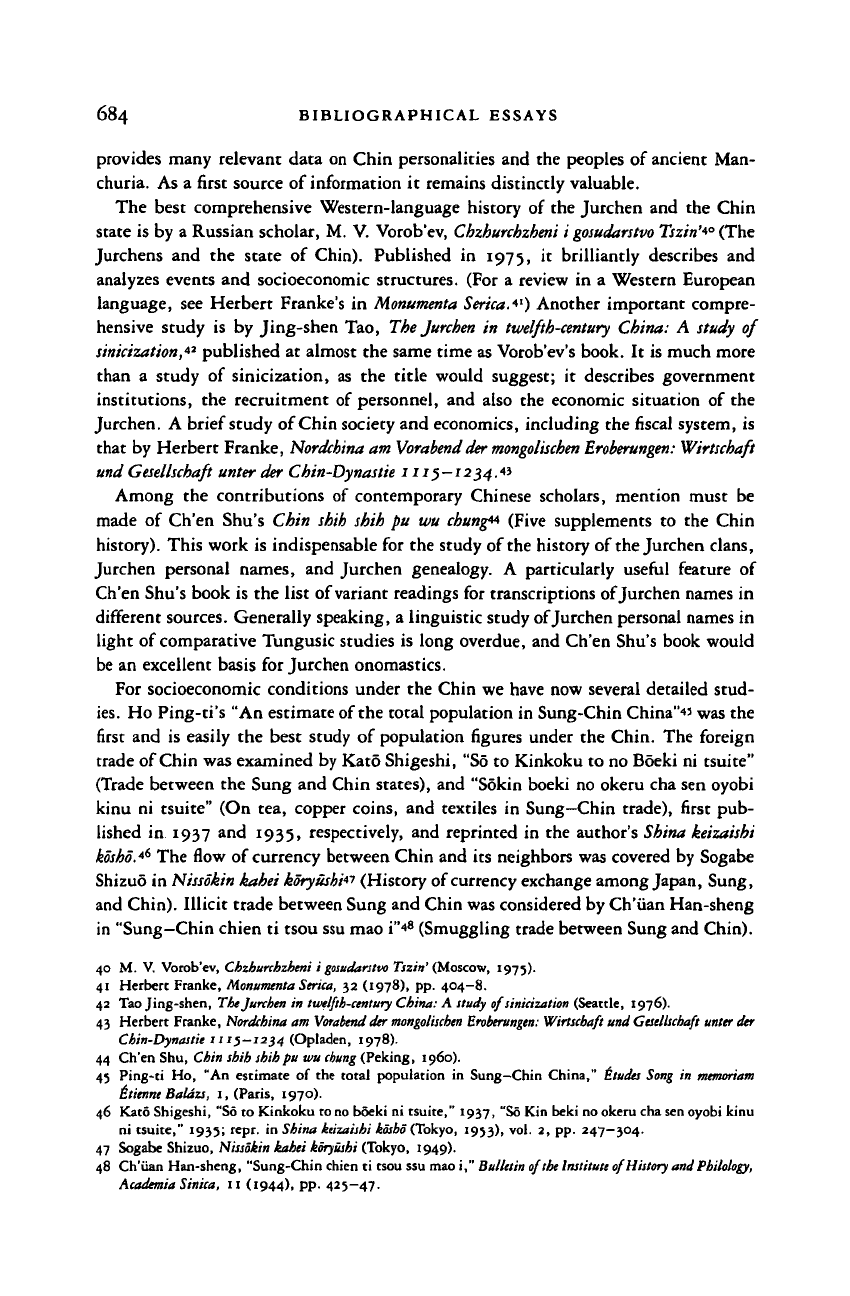
684 BIBLIOGRAPHICAL ESSAYS
provides many relevant data on Chin personalities and the peoples of ancient Man-
churia. As a first source of information it remains distinctly valuable.
The best comprehensive Western-language history of the Jurchen and the Chin
state is by a Russian scholar, M. V. Vorob'ev,
Chzhurchzheni
i
gosudarstvo Tszin'*°
(The
Jurchens and the state of Chin). Published in 1975, it brilliantly describes and
analyzes events and socioeconomic structures. (For a review in a Western European
language, see Herbert Franke's in
Monumenta Serica.*')
Another important compre-
hensive study is by Jing-shen Tao,
The Jurchen
in
twelfth-century
China:
A study of
sinicization,*
1
published at almost the same time as Vorob'ev's book. It is much more
than a study of sinicization, as the title would suggest; it describes government
institutions, the recruitment of personnel, and also the economic situation of the
Jurchen. A brief study of Chin society and economics, including the fiscal system, is
that by Herbert Franke,
Nordcbina
am Vorabend
der mongolischen
Eroberungen:
Wirtschaft
undGesellschaft unter der Chin-Dynastie 1115-1234.V
Among the contributions of contemporary Chinese scholars, mention must be
made of Ch'en Shu's Chin shih shih pu wu
chung**
(Five supplements to the Chin
history). This work is indispensable for the study of the history of
the
Jurchen clans,
Jurchen personal names, and Jurchen genealogy. A particularly useful feature of
Ch'en Shu's book is the list of variant readings for transcriptions of Jurchen names in
different sources. Generally speaking, a linguistic study of Jurchen personal names in
light of comparative Tungusic studies is long overdue, and Ch'en Shu's book would
be an excellent basis for Jurchen onomastics.
For socioeconomic conditions under the Chin we have now several detailed stud-
ies.
Ho Ping-ti's "An estimate of the total population in Sung-Chin China"
43
was the
first and is easily the best study of population figures under the Chin. The foreign
trade of Chin was examined by Kato Shigeshi, "So to Kinkoku to no Boeki ni tsuite"
(Trade between the Sung and Chin states), and "Sokin boeki no okeru cha sen oyobi
kinu ni tsuite" (On tea, copper coins, and textiles in Sung—Chin trade), first pub-
lished in 1937 and 1935, respectively, and reprinted in the author's
Shina keizaishi
kosho.*
6
The flow of currency between Chin and its neighbors was covered by Sogabe
Shizuo in
Nissokin kahei koryushiv
(History of currency exchange among Japan, Sung,
and Chin). Illicit trade between Sung and Chin was considered by Ch'iian Han-sheng
in "Sung—Chin chien ti tsou ssu mao i"
4
* (Smuggling trade between Sung and Chin).
40 M. V. Vorob'ev, Chzhunhzbeni i
gosudarstvo
Tszin'(Moscow, 1975).
41 Herbert Franke, Monumtnta
Serica,
32 (1978), pp. 404-8.
42 Tao Jing-shen, The Jurchen in
twelfth-century
China: A study of sinicization (Seattle, 1976).
43 Herbert Franke, Nordchina am
Vorabend
der
mongolischen
Eroberungen:
Wirtscbaft und
Gesellschaft unter
der
Chin-Dynastie in)—1234 (Opladen, 1978).
44 Ch'en Shu, Chin shih shih pu wu
(hung
(Peking, i960).
43 Ping-ti Ho, "An estimate of the total population in Sung—Chin China," Etudes Song in memoriam
ttienne Baldzs, 1, (Paris, 1970).
46 Kato Shigeshi, "So to Kinkoku to no boeki ni tsuite," 1937, "So Kin beki no okeru cha sen oyobi kinu
ni tsuite," 1935; repr. in Shina keizaishi
kosbo
(Tokyo, 1953), vol. 2, pp. 247—304.
47 Sogabe Shizuo, Nissokin kahei
koryushi
(Tokyo, 1949).
48 Ch'iian Han-sheng, "Sung-Chin chien ti tsou ssu mao i," Bulletin
of the
Institute
of
History and
Philology,
Academia Sinica, 11 (1944), pp. 423—47.
Cambridge Histories Online © Cambridge University Press, 2008

BIBLIOGRAPHICAL ESSAYS 685
A brief but succinct description of the Chin economy is that by Chang Po-ch'iian,
Cbin-tai ching-chi
shih-liieh*
9
(Outline of economic history of the Chin dynasty). The
tea monopoly of the Chin was competently described by Hok-lam Chan in "Tea
production and tea trade under the Jurchen-Chin,"'° and the rather inefficient wine
monopoly of the Chin was discussed summarily by Herbert Franke in "A note on
wine."
5
'
There are several modern studies in Western languages concerning the diplomatic
and military relations between Sung and Chin. Dagmar Thiele,
Der Abschluss eines
Vertraga:
Diplomatic zwischen Sung-undChin-Dynastie
1117-1123,1*
describes in great
detail the attempts of the Sung government to conclude a treaty with the emerging
state of Chin in order to overthrow the already-toppling Liao dynasty, and the
eventual break between Chin and Sung that led to the annihilation of the Northern
Sung state.
A textual study of the treaties between the two powers is that by Herbert Franke,
"Treaties between Sung and Chin."" This covers the period up to the peace treaty of
1141 and also gives some information on later agreements. An episode of the war
between the two states in 1205—8 is the subject of Corinna Hana's
Bericht iiber
die
Verteidigung
der Stadt Te-an wahrend der
Periode
K'ai-hsi 1205 bis 1208.™ This book
includes not only a profusely annotated translation of the siege diary written by an
eyewitness of the battles for the strategic town of Te-an but describes also the various
embassies between Sung and Chin that led to a renewal of earlier treaties and the
resumption of a precarious coexistence between Sung and Chin. Another study
dealing with the Jurchen defector P'u-hsien Wan-nu, who established an ephemeral
state of
his
own in Manchuria, is that by Iwai Hirosato, "The source and meaning of
Ta-chen, the dynastic title of P'u-hsien Wan-nu."» The relations between the Chin
state and Kory6 have been much studied by Michael.C. Rogers, "Studies in Korean
history II: Kory6's military dictatorship and its relations with Chin," and "The
regularization of Kory6—Chin relations (1116—1131)."
56
These articles are based on
both Chinese and Korean sources.
The civilization of the early Jurchen has been studied through translations of
relevant texts; see Herbert Franke, "Chinese texts on the Jurchen: Translation of the
49 Chang Po-ch'iian, Chin-lai
ching
chi shih liieh (Shen-yang, 1981).
50 Chan Hok-lam, "Tea production and tea trade under the Jurchen—Chin dynasty," ed. Wolfgang Bauer,
Studia
Sino-Mongolica,
Festschrift fiir
Herbert
Franke (Wiesbaden, 1979), pp. 104-25.
51 Herbert Franke, "A note on wine,"
Zentralasiatische
Sludien, 8 (1974), pp. 241-5.
52 Dagmar Thiele, Der
Abschluss eines
Vertraga: Diplomatic
zwischen
Sung undChin Dynastie my—112)
(Wiesbaden, 1971).
53 Herbert Franke, "Treaties between Sung and Chin," in ttudes Song in
memoriam
ttienne Balazs, 1,
(1970),
pp. 55-84.
54 Corinna Hana, Bericht
iiber
die
Verteidigung
der Stadt Te-an wdhrend der
Periode
K'ai-hsi 1203 bis 1208
(Wiesbaden, 1970).
55 Hirosato Iwai, "The source and meaning of Ta-chen, the dynastic title of P'u-hsien Wan-nu,"
Memoirs
0/the
Research Department
of the Toyo
bunko,
9 (1937), pp. 111-61.
56 Michael C. Rogers, "Studies in Korean history, II: Koryd's military dictatorship and its relations with
Chin,"
T'oung
Poo, 47 (1959), pp. 42-62; Michael C. Rogers, "The regularization of Kory6-Chin
relations (1116—1131)," Central Asiatic Journal, 6(1961),pp. 51-84.
Cambridge Histories Online © Cambridge University Press, 2008
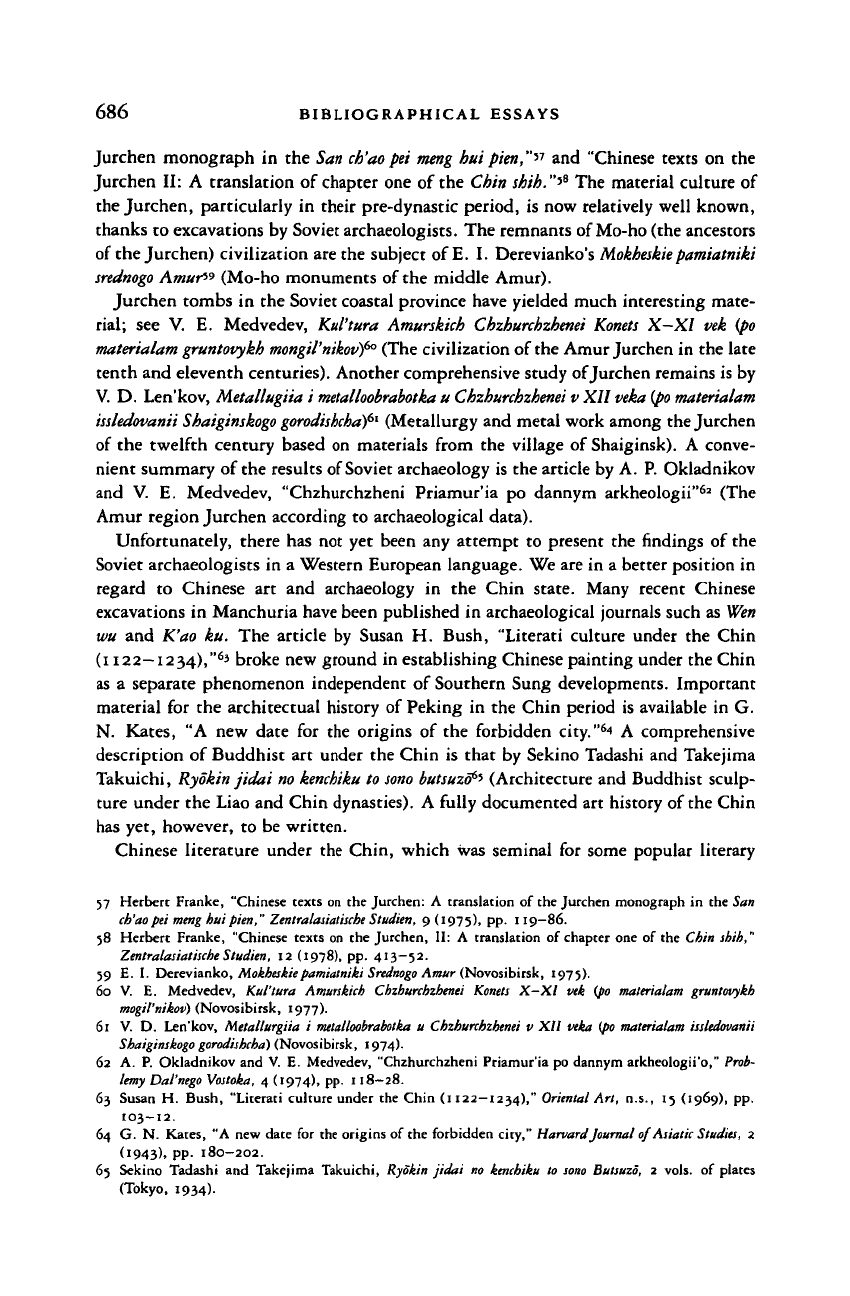
686 BIBLIOGRAPHICAL ESSAYS
Jurchen monograph
in
the
San ch'ao pet meng
hut
pien,"'>
1
and "Chinese texts on the
Jurchen II: A translation of chapter one of the
Chin
shih."*
8
The material culture of
the Jurchen, particularly in their pre-dynastic period, is now relatively well known,
thanks to excavations by Soviet archaeologists. The remnants of
Mo-ho
(the ancestors
of the Jurchen) civilization are the subject of
E.
I.
Derevianko's
Mokheskiepamiatniki
srednogo
Amur**
(Mo-ho monuments of the middle Amur).
Jurchen tombs in the Soviet coastal province have yielded much interesting mate-
rial;
see V. E.
Medvedev, Kul'tura Amurskich Chzhurchzhenei Konets
X—XI
vek (po
materialam gruntovykh mongil'nikovf°
(The civilization of
the
Amur Jurchen in the late
tenth and eleventh centuries). Another comprehensive study of Jurchen remains is by
V. D. Len'kov,
Metallugiia
i
metalloobrabotka
u
Chzhurchzhenei
v XII
veka (po materialam
issledovanii Shaiginskogo
gorodishcha)
61
(Metallurgy and metal work among
the
Jurchen
of the twelfth century based on materials from the village of Shaiginsk). A conve-
nient summary of the results of Soviet archaeology is the article by A. P. Okladnikov
and V.
E.
Medvedev, "Chzhurchzheni Priamur'ia po dannym arkheologii"
62
(The
Amur region Jurchen according to archaeological data).
Unfortunately, there has not yet been any attempt to present the findings of the
Soviet archaeologists in a Western European language. We are in a better position in
regard
to
Chinese
art and
archaeology
in the
Chin state. Many recent Chinese
excavations in Manchuria have been published in archaeological journals such as
Wen
wu and K'ao ku. The article by Susan
H.
Bush, "Literati culture under the Chin
(i 122—1234),"
6j
broke new ground in establishing Chinese painting under the Chin
as
a
separate phenomenon independent of Southern Sung developments. Important
material for the architectual history of Peking in the Chin period is available in G.
N.
Kates,
"A
new date
for
the origins
of
the forbidden city."
6
* A comprehensive
description of Buddhist art under the Chin
is
that by Sekino Tadashi and Takejima
Takuichi,
Ryokin
jidai
no kenchiku to sono
butsuzb**
(Architecture and Buddhist sculp-
ture under the Liao and Chin dynasties). A fully documented art history of the Chin
has yet, however, to be written.
Chinese literature under the Chin, which was seminal for some popular literary
57 Herbert Franke, "Chinese texts on the Jurchen:
A
translation
of
the Jurchen monograph
in
the San
ch'aopei menghuipirn," ZentralasiatischeStudien, 9(1975), pp. 119—86.
58 Herbert Franke, "Chinese texts on the Jurchen,
II: A
translation
of
chapter one
of
the Chin shih,"
Zentralasiatische Studien, 12 (1978), pp. 413—52.
59
E. I.
Derevianko,
Mokheskie
pamiatniki
Srednogo
Amur (Novosibirsk, 1975).
60
V. E.
Medvedev, Kul'tura Amurskich Chzhurchzhenei Konets
X-XI vek (po
materialam gruntovykh
mogil'nikov) (Novosibirsk, 1977).
61
V. D.
Len'kov, Metallurgiia
i
metalloobrabotka
u
Chzhurchzhenei
v XII
veka (po materialam issledovanii
Shaiginskogo gorodishcha)
(Novosibirsk, 1974).
62
A. P.
Okladnikov and V.
E.
Medvedev, "Chzhurchzheni Priamur'ia po dannym arkheologii'o," Prob-
lemy Dal'nego Vostoka,
4
(1974), pp. 118-28.
63 Susan
H.
Bush, "Literati culture under the Chin (1122—1234)," Oriental Art, n.s.,
15
(1969),
pp.
103-12.
64
G. N.
Kates, "A new date for the origins
of
the forbidden city," Harvard Journal of Asiatic
Studies,
2
(1943), pp. 180—202.
65 Sekino Tadashi and Takejima Takuichi, Ryokin jidai no kenchiku
to
sono
Butsuzo,
2
vols.
of
plates
(Tokyo, 1934).
Cambridge Histories Online © Cambridge University Press, 2008
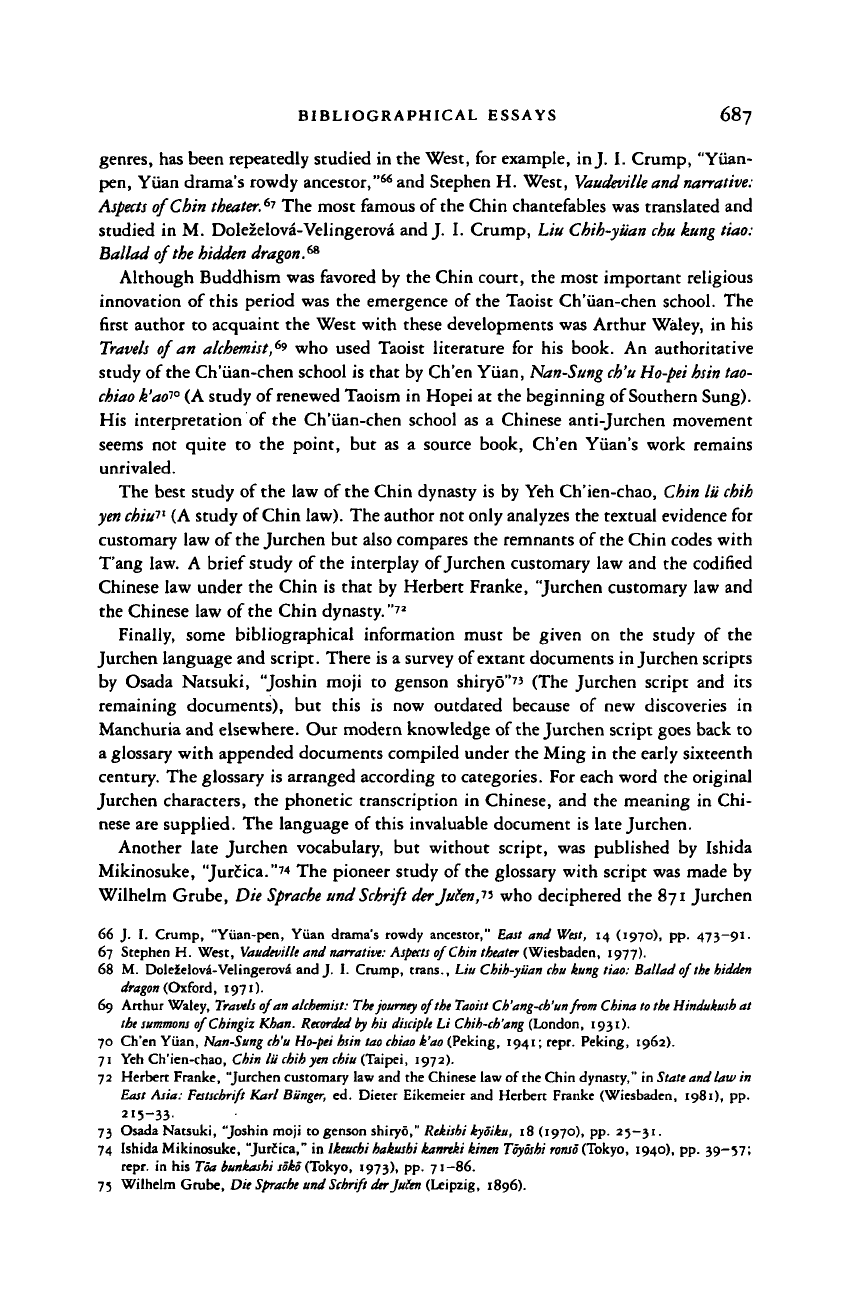
BIBLIOGRAPHICAL ESSAYS 687
genres, has been repeatedly studied in the West, for example, in J. I. Crump, "Yuan-
pen, Yuan drama's rowdy ancestor,"
66
and Stephen H. West,
Vaudeville and
narrative:
Aspects
of
Chin
theater.
6
'
1
The most famous of the Chin chantefables was translated and
studied in M. Dolezelova-Velingerova andJ. I. Crump, Liu
Chih-yiian chu kung
tiao:
Ballad of the hidden dragon.
6
*
Although Buddhism was favored by the Chin court, the most important religious
innovation of this period was the emergence of the Taoist Ch'uan-chen school. The
first author to acquaint the West with these developments was Arthur Waley, in his
Travels
of
an
alchemist,
69
who used Taoist literature for his book. An authoritative
study of
the
Ch'iian-chen school is that by Ch'en Yuan,
Nan-Sung ch'u Ho-pei hsin
tao-
chiao
k'ao
10
(A study of renewed Taoism in Hopei at the beginning of Southern Sung).
His interpretation of the Ch'uan-chen school as a Chinese anti-Jurchen movement
seems not quite to the point, but as a source book, Ch'en Yiian's work remains
unrivaled.
The best study of the law of the Chin dynasty is by Yeh Ch'ien-chao,
Chin lit chih
yen
chiu
11
(A study of Chin
law).
The author not only analyzes the textual evidence for
customary law of the Jurchen but also compares the remnants of the Chin codes with
T'ang law. A brief study of the interplay of Jurchen customary law and the codified
Chinese law under the Chin is that by Herbert Franke, "Jurchen customary law and
the Chinese law of the Chin
dynasty.
"
72
Finally, some bibliographical information must be given on the study of the
Jurchen language and script. There is a survey of extant documents in Jurchen scripts
by Osada Natsuki, "Joshin moji to genson shiryo"
73
(The Jurchen script and its
remaining documents), but this is now outdated because of new discoveries in
Manchuria and elsewhere. Our modern knowledge of the Jurchen script goes back to
a glossary with appended documents compiled under the Ming in the early sixteenth
century. The glossary is arranged according to categories. For each word the original
Jurchen characters, the phonetic transcription in Chinese, and the meaning in Chi-
nese are supplied. The language of this invaluable document is late Jurchen.
Another late Jurchen vocabulary, but without script, was published by Ishida
Mikinosuke, "Jurcica."'
1
' The pioneer study of the glossary with script was made by
Wilhelm Grube,
Die Sprache und Schrift
derjulen,
1
^
who deciphered the 871 Jurchen
66 J. I. Crump, "Yuan-pen, Yuan drama's rowdy ancestor," East and
West,
14 (1970), pp. 473-91.
67 Stephen H. West,
Vaudeville
and narrative:
Aspects
ofChin theater (Wiesbaden, 1977).
68 M. Dolefelovd-Velingerovi and J. I. Crump, trans., Liu Chih-yiian
chu
kung tiao: Ballad of
the
hidden
dragon
(Oxford, 1971).
69 Arthur Waley,
Travels
of an
alchemist:
The journey of the
Taoist
Ch'ang-ch'un from China to
the Hindukush
at
the
summons
ofChingiz Khan.
Recorded
by his
disciple
Li
Chih-ch'ang
(London, 1931).
70 Ch'en Yuan, Nan-Sung
ch'u
Ho-pei hsin tao
chiao
k'ao (Peking, 1941; repr. Peking, 1962).
71 Yeh Ch'ien-chao, Chin lit
chih
yen chiu (Taipei, 1972).
72 Herbert Franke, "Jurchen customary law and the Chinese law of the Chin dynasty," in State and law in
East Asia:
Festschrift
Karl
Biinger,
ed. Dieter Eikemeier and Herbert Franke (Wiesbaden, 1981), pp.
215-33.
73 Osada Natsuki, "Joshin moji to genson shiryo," Rekisbi kyoiku, 18 (1970), pp.
25-31.
74 Ishida Mikinosuke, "Jurfica," in
Ikeuchi
hakushi kanreki kinen
Toyoshi ronso
(Tokyo, 1940), pp. 39—57;
repr. in his Toa bunkashi
soko
(Tokyo, 1973), pp. 71—86.
75 Wilhelm Grube, Die
Sprache
und
Schrift
derjulen (Leipzig, 1896).
Cambridge Histories Online © Cambridge University Press, 2008
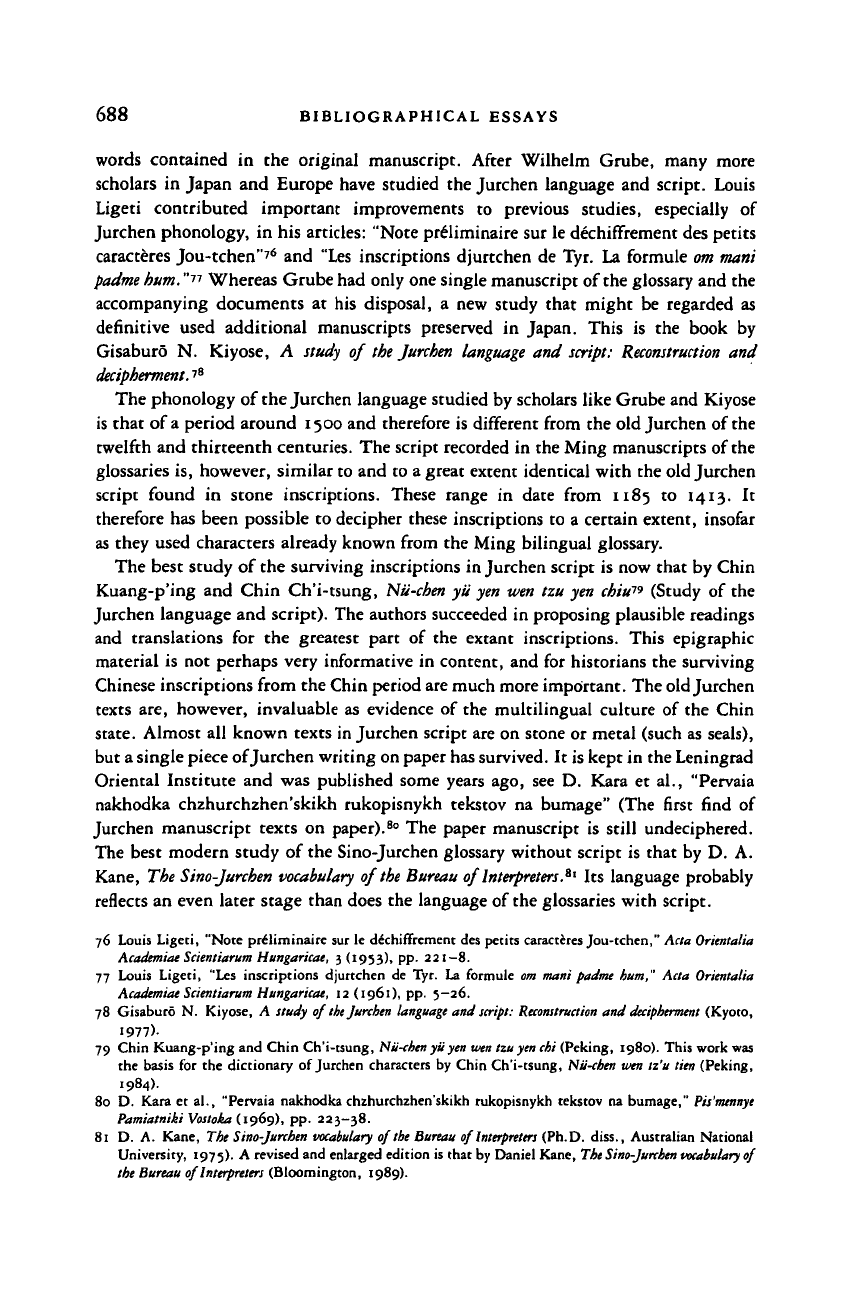
688 BIBLIOGRAPHICAL ESSAYS
words contained in the original manuscript. After Wilhelm Grube, many more
scholars in Japan and Europe have studied the Jurchen language and script. Louis
Ligeti contributed important improvements to previous studies, especially of
Jurchen phonology, in his articles: "Note pr£liminaire sur le dechifrrement des petits
caracteres Jou-tchen"
76
and "Les inscriptions djurtchen de Tyr. La formule
om mani
padme
hum."" Whereas Grube had only one single manuscript of the glossary and the
accompanying documents at his disposal, a new study that might be regarded as
definitive used additional manuscripts preserved in Japan. This is the book by
Gisaburo N. Kiyose, A study of the
Jurchen
language and script:
Reconstruction
and
decipherment.
'
8
The phonology of the Jurchen language studied by scholars like Grube and Kiyose
is that of
a
period around 1500 and therefore is different from the old Jurchen of the
twelfth and thirteenth centuries. The script recorded in the Ming manuscripts of the
glossaries is, however, similar to and to a great extent identical with the old Jurchen
script found in stone inscriptions. These range in date from 1185 to 1413. It
therefore has been possible to decipher these inscriptions to a certain extent, insofar
as they used characters already known from the Ming bilingual glossary.
The best study of the surviving inscriptions in Jurchen script is now that by Chin
Kuang-p'ing and Chin Ch'i-tsung,
Nii-chen
yii
yen wen
tzu
yen
chiu
19
(Study of the
Jurchen language and script). The authors succeeded in proposing plausible readings
and translations for the greatest part of the extant inscriptions. This epigraphic
material is not perhaps very informative in content, and for historians the surviving
Chinese inscriptions from the Chin period are much more important. The old Jurchen
texts are, however, invaluable as evidence of the multilingual culture of the Chin
state.
Almost all known texts in Jurchen script are on stone or metal (such as seals),
but
a
single piece of Jurchen writing on paper has survived. It is kept in the Leningrad
Oriental Institute and was published some years ago, see D. Kara et al., "Pervaia
nakhodka chzhurchzhen'skikh rukopisnykh tekstov na bumage" (The first find of
Jurchen manuscript texts on paper).
80
The paper manuscript is still undeciphered.
The best modern study of the Sino-Jurchen glossary without script is that by D. A.
Kane, The
Sino-Jurchen vocabulary
of the Bureau of Interpreters .
tl
Its language probably
reflects an even later stage than does the language of the glossaries with script.
76 Louis Ligeti, "Note priliminaire sur le dechiffrement des petits caracteres Jou-tchen," Ada Onentalia
Academiae Scientiarum Hungarian, 3 (1933), pp- 221—8.
77 Louis Ligeti, "Les inscriptions djurtchen de Tyr. La formule om mani padmt hum," Ada Onentalia
Academiae Scientiarum Hungaricae, 12 (1961), pp. 5-26.
78 Gisaburo N. Kiyose, A study of tht Jurchen
language
and
script:
Reconstruction
and
decipherment
(Kyoto,
1977)-
79 Chin Kuang-p'ing and Chin Ch'i-tsung,
Nii-chen
yu
yen wen
tzu
yen
chi (Peking, 1980). This work was
the basis for the dictionary of Jurchen characters by Chin Ch'i-tsung, Nii-chen wen tz'u lien (Peking,
1984).
80 D. Kara et al., "Pervaia nakhodka chzhurchzhen'skikh rukopisnykh tekstov na bumage,"
Pis'mennye
Pamiatniki
Vostoka
(1969), pp. 223-38.
81 D. A. Kane, The
Sino-Jurchen vocabulary
of
the
Bureau of
Interpreters
(Ph.D. diss., Australian National
University, 197;). A revised and enlarged edition is that by Daniel Kane,
The Sino-Jurchen vocabulary of
the Bureau of
Interpreters
(Bloomington, 1989).
Cambridge Histories Online © Cambridge University Press, 2008
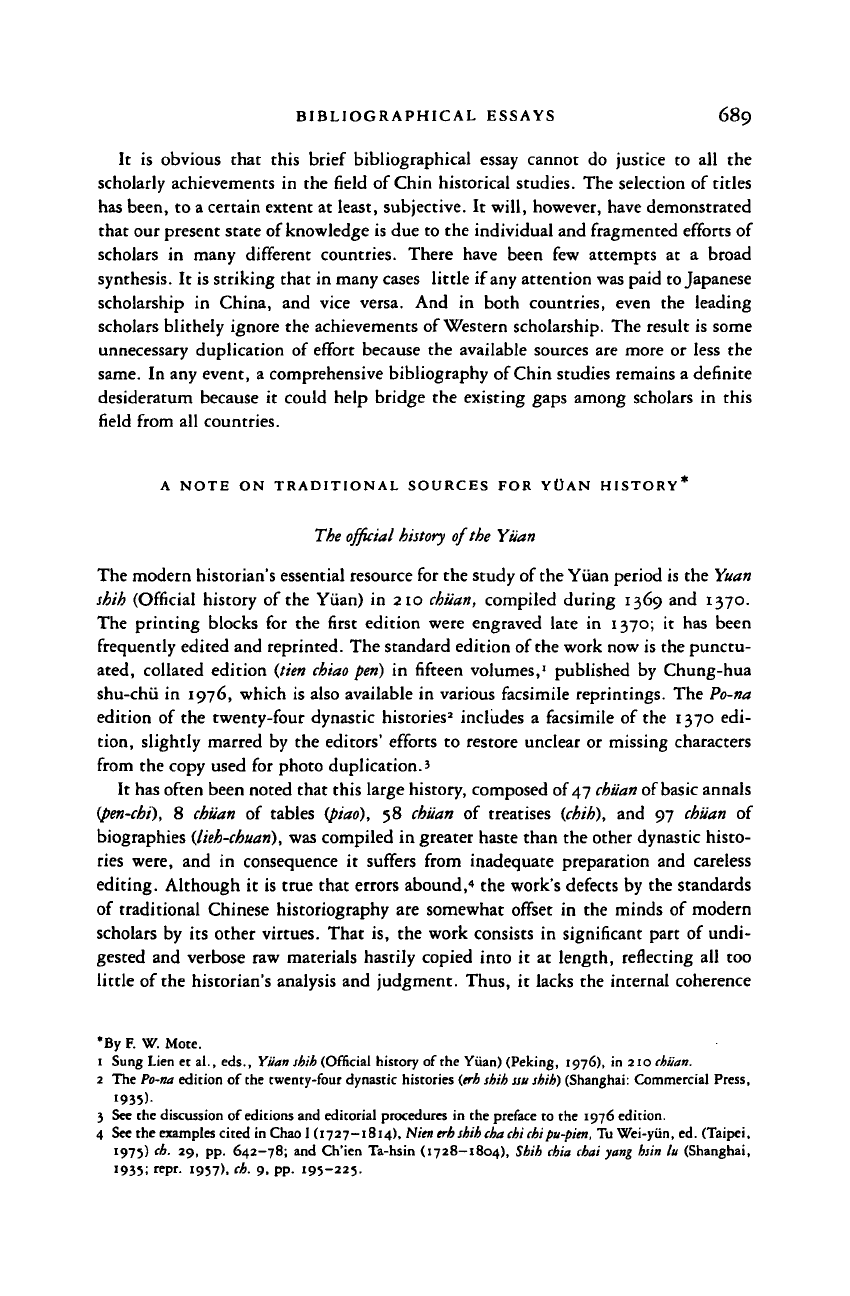
BIBLIOGRAPHICAL ESSAYS 689
It is obvious that this brief bibliographical essay cannot do justice to all the
scholarly achievements in the field of Chin historical studies. The selection of titles
has been, to a certain extent at least, subjective. It will, however, have demonstrated
that our present state of knowledge is due to the individual and fragmented efforts of
scholars in many different countries. There have been few attempts at a broad
synthesis. It is striking that in many cases little if any attention was paid
to
Japanese
scholarship in China, and vice versa. And in both countries, even the leading
scholars blithely ignore the achievements of Western scholarship. The result is some
unnecessary duplication of effort because the available sources are more or less the
same. In any event, a comprehensive bibliography of Chin studies remains a definite
desideratum because it could help bridge the existing gaps among scholars in this
field from all countries.
A NOTE ON TRADITIONAL SOURCES FOR YUAN HISTORY
The
official history
of the Yuan
The modern historian's essential resource for the study of the Yuan period is the
Yuan
shih (Official history of the Yuan) in 210
chiian,
compiled during 1369 and 1370.
The printing blocks for the first edition were engraved late in 1370; it has been
frequently edited and reprinted. The standard edition of
the
work now is the punctu-
ated, collated edition
(fien chiao peri)
in fifteen volumes,
1
published by Chung-hua
shu-chii in 1976, which is also available in various facsimile reprintings. The
Po-na
edition of the twenty-four dynastic histories
2
includes a facsimile of the 1370 edi-
tion, slightly marred by the editors' efforts to restore unclear or missing characters
from the copy used for photo duplication.'
It has often been noted that this large history, composed of 47
chiian
of basic annals
(pen-chi),
8 chiian of tables (piao), 58 chiian of treatises (chih), and 97 chiian of
biographies
{lieh-chuan),
was compiled in greater haste than the other dynastic histo-
ries were, and in consequence it suffers from inadequate preparation and careless
editing. Although it is true that errors abound,
4
the work's defects by the standards
of traditional Chinese historiography are somewhat offset in the minds of modern
scholars by its other virtues. That is, the work consists in significant part of undi-
gested and verbose raw materials hastily copied into it at length, reflecting all too
little of the historian's analysis and judgment. Thus, it lacks the internal coherence
•By F. W. Mote.
1 Sung Lien et al., eds., Yuan shih (Official history of the Yuan) (Peking, 1976), in 210 chiian.
2 The Po-na edition of the twenty-four dynastic histories
(erh
shih
ssu
shih) (Shanghai: Commercial Press,
1935)-
3 See the discussion of editions and editorial procedures in the preface to the 1976 edition.
4 See the examples cited inChaol (1727—1814), Nien
erh
shih
cha chi cbi
pu-pien,
Tu Wei-yiin, ed. (Taipei,
1975) cb. 29, pp. 642-78; and Ch'ien Ta-hsin (1728-1804), Shih chia thai yang hsin lu (Shanghai,
1935;
repr. 1957), ch. 9, pp. 195-225-
Cambridge Histories Online © Cambridge University Press, 2008
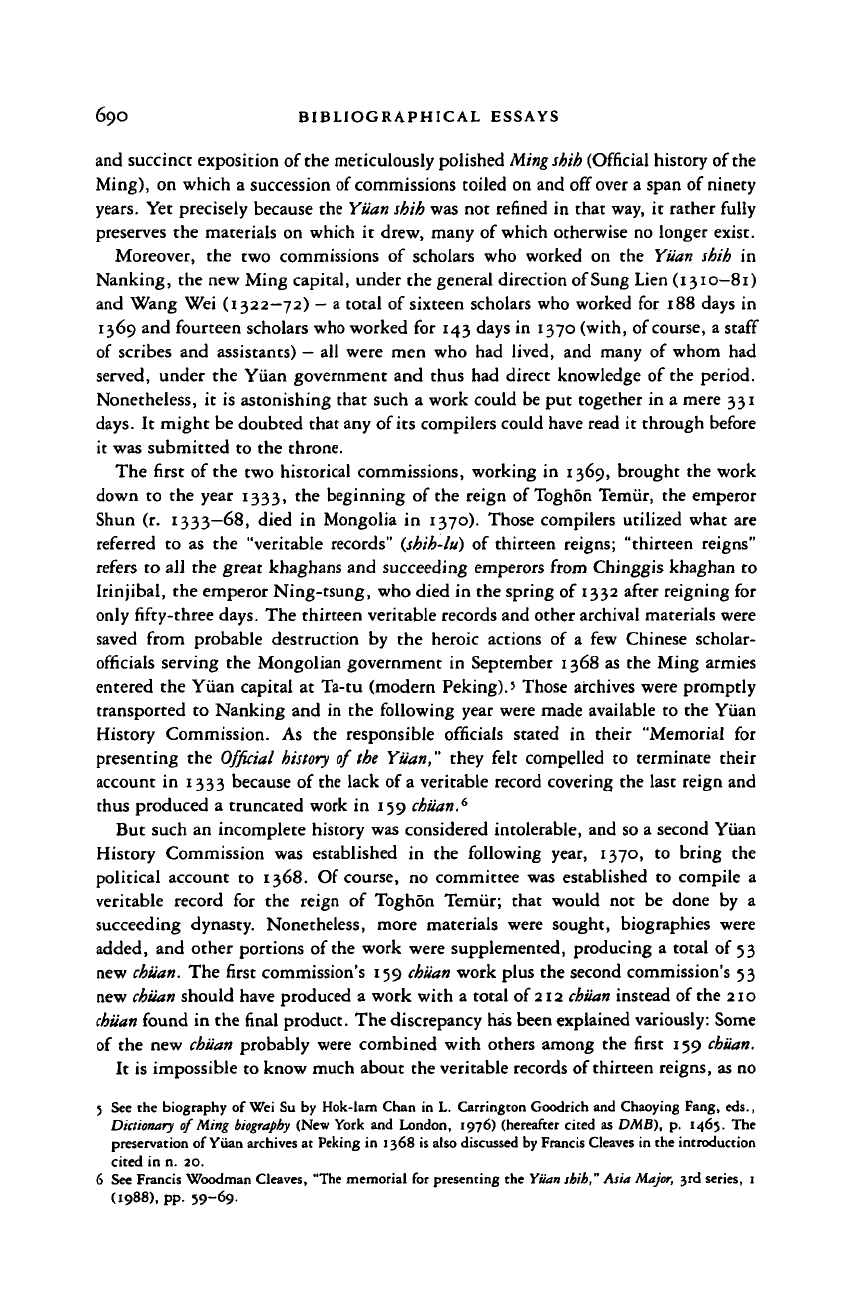
690 BIBLIOGRAPHICAL ESSAYS
and succinct exposition of the meticulously polished
Mingshih
(Official history of the
Ming),
on which a succession of commissions toiled on and off over a span of ninety
years.
Yet precisely because the Yuan
shih
was not refined in that way, it rather fully
preserves the materials on which it drew, many of which otherwise no longer exist.
Moreover, the two commissions of scholars who worked on the Yuan shih in
Nanking, the new Ming capital, under the general direction of Sung Lien (1310—81)
and Wang Wei (1322—72)
—
a total of sixteen scholars who worked for 188 days in
1369 and fourteen scholars who worked for 143 days in 1370 (with, of
course,
a staff
of scribes and assistants)
—
all were men who had lived, and many of whom had
served, under the Yuan government and thus had direct knowledge of the period.
Nonetheless, it is astonishing that such a work could be put together in a mere 331
days.
It might be doubted that any of
its
compilers could have read it through before
it was submitted to the throne.
The first of the two historical commissions, working in 1369, brought the work
down to the year 1333, the beginning of the reign of Togh5n Temiir, the emperor
Shun (r. 1333—68, died in Mongolia in 1370). Those compilers utilized what are
referred to as the "veritable records"
(shih-lu)
of thirteen reigns; "thirteen reigns"
refers to all the great khaghans and succeeding emperors from Chinggis khaghan to
Irinjibal, the emperor Ning-tsung, who died in the spring of 1332 after reigning for
only fifty-three days. The thirteen veritable records and other archival materials were
saved from probable destruction by the heroic actions of a few Chinese scholar-
officials serving the Mongolian government in September 1368 as the Ming armies
entered the Yuan capital at Ta-tu (modern Peking).5 Those archives were promptly
transported to Nanking and in the following year were made available to the Yuan
History Commission. As the responsible officials stated in their "Memorial for
presenting the
Official history
of
the
Yuan," they felt compelled to terminate their
account in 1333 because of the lack of a veritable record covering the last reign and
thus produced a truncated work in 159
chiian.
6
But such an incomplete history was considered intolerable, and so a second Yuan
History Commission was established in the following year, 1370, to bring the
political account to 1368. Of course, no committee was established to compile a
veritable record for the reign of Toghon Temiir; that would not be done by a
succeeding dynasty. Nonetheless, more materials were sought, biographies were
added, and other portions of the work were supplemented, producing a total of 53
new
chiian.
The first commission's 159
chiian
work plus the second commission's 53
new
chiian
should have produced a work with a total of
212 chiian
instead of the 210
chiian
found in the final product. The discrepancy has been explained variously: Some
of the new
chiian
probably were combined with others among the first 159
chiian.
It is impossible to know much about the veritable records of thirteen reigns, as no
5 See the biography of Wei Su by Hok-tam Chan in L. Carrington Goodrich and Chaoying Fang, eds.,
Dictionary of Ming biography (New York and London, 1976) (hereafter cited as DMB), p. 1465. The
preservation of Yuan archives at Peking in 1368 is also discussed by Francis Cleaves in the introduction
cited in n. 20.
6 See Francis Woodman Cleaves, "The memorial for presenting the Yuan sbib," Asia Major, 3rd series, 1
(1988),
pp. 59-69-
Cambridge Histories Online © Cambridge University Press, 2008
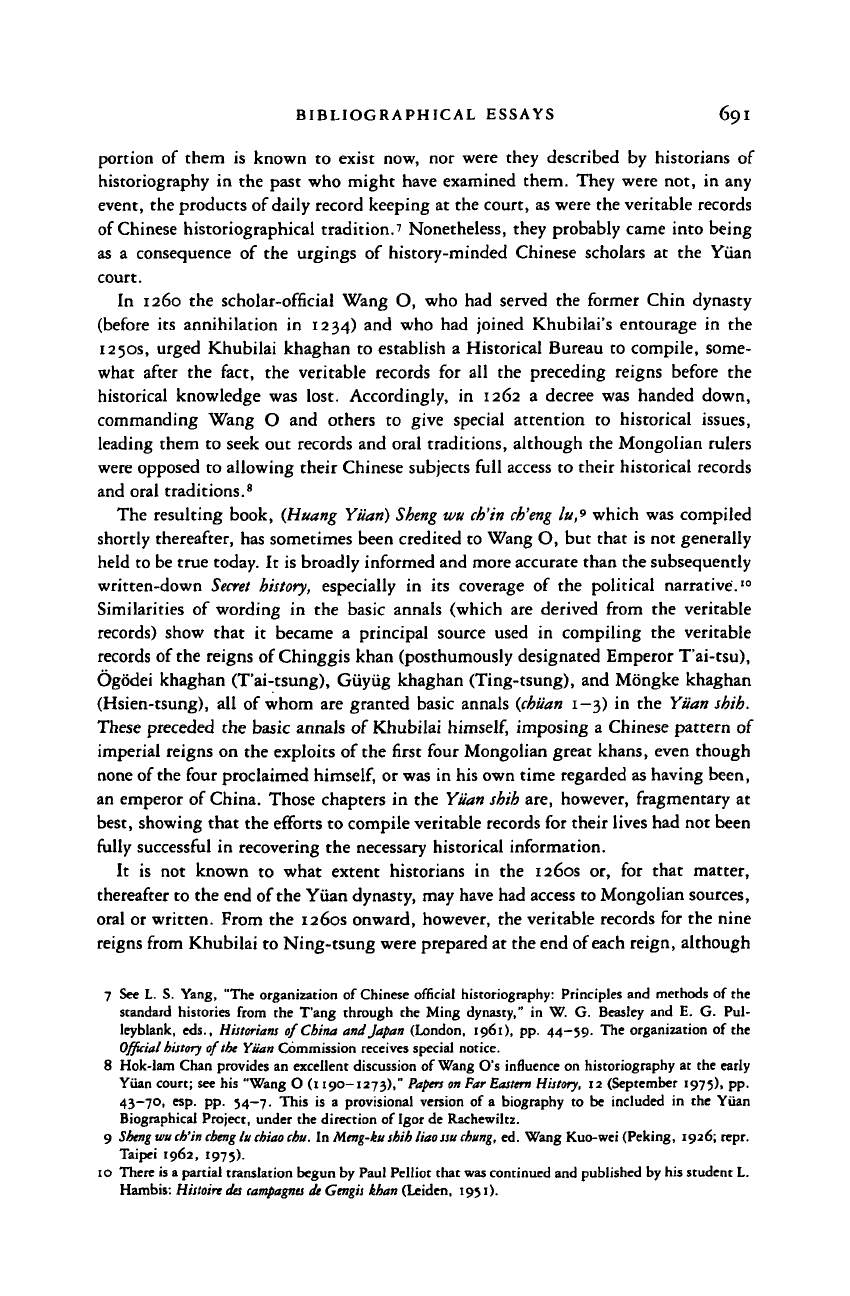
BIBLIOGRAPHICAL ESSAYS 691
portion of them is known to exist now, nor were they described by historians of
historiography in the past who might have examined them. They were not, in any
event, the products of daily record keeping at the court, as were the veritable records
of Chinese historiographical tradition.
7
Nonetheless, they probably came into being
as a consequence of the urgings of history-minded Chinese scholars at the Yuan
court.
In 1260 the scholar-official Wang O, who had served the former Chin dynasty
(before its annihilation in 1234) and who had joined Khubilai's entourage in the
1250s, urged Khubilai khaghan to establish a Historical Bureau to compile, some-
what after the fact, the veritable records for all the preceding reigns before the
historical knowledge was lost. Accordingly, in 1262 a decree was handed down,
commanding Wang O and others to give special attention to historical issues,
leading them to seek out records and oral traditions, although the Mongolian rulers
were opposed to allowing their Chinese subjects full access to their historical records
and oral traditions.
8
The resulting book, (Huang Yuan)
Sheng
wu
ch'in ch'eng
lu,
9
which was compiled
shortly thereafter, has sometimes been credited to Wang O, but that is not generally
held to be true today. It is broadly informed and more accurate than the subsequently
written-down
Secret
history,
especially in its coverage of the political narrative.
10
Similarities of wording in the basic annals (which are derived from the veritable
records) show that it became a principal source used in compiling the veritable
records of the reigns of Chinggis khan (posthumously designated Emperor T'ai-tsu),
Ogodei khaghan (T'ai-tsung), Giiyiig khaghan (Ting-tsung), and Mongke khaghan
(Hsien-tsung), all of whom are granted basic annals
(chiian
1-3) in the Yuan shih.
These preceded the basic annals of Khubilai
himself,
imposing a Chinese pattern of
imperial reigns on the exploits of the first four Mongolian great khans, even though
none of the four proclaimed
himself,
or was in his own time regarded as having been,
an emperor of China. Those chapters in the
Yuan shih
are, however, fragmentary at
best, showing that the efforts to compile veritable records for their lives had not been
fully successful in recovering the necessary historical information.
It is not known to what extent historians in the 1260s or, for that matter,
thereafter to the end of
the
Yuan dynasty, may have had access to Mongolian sources,
oral or written. From the 1260s onward, however, the veritable records for the nine
reigns from Khubilai to Ning-tsung were prepared at the end of each reign, although
7 See L. S. Yang, "The organization of Chinese official historiography: Principles and methods of the
standard histories from the Tang through the Ming dynasty," in W. G. Beasley and E. G. Pul-
leyblanlc, eds., Historians of China and Japan (London, 1961), pp. 44-39. The organization of the
Official history
of the Yuan Commission receives special notice.
8 Hok-lam Chan provides an excellent discussion of Wang O's influence on historiography at the early
Yiian court; see his "Wang O (1190-1273),"
Papers on
Far
Eastern
History, 12 (September 1975), pp.
43—70,
esp. pp. 54—7. This is a provisional version of a biography to be included in the Yiian
Biographical Project, under the direction of Igor de Rachewiltz.
9
Sheng
wu
ch'in cheng
lu
chiao
chu.
In Meng-ku shih liao
ssu
chung,
ed. Wang Kuo-wei (Peking, 1926; repr.
Taipei 1962, 1975).
10 There is a partial translation begun by Paul Pelliot that was continued and published by his student L.
Hambis: Histoire da
campagnts
de Gengis khan (Leiden, 1951).
Cambridge Histories Online © Cambridge University Press, 2008
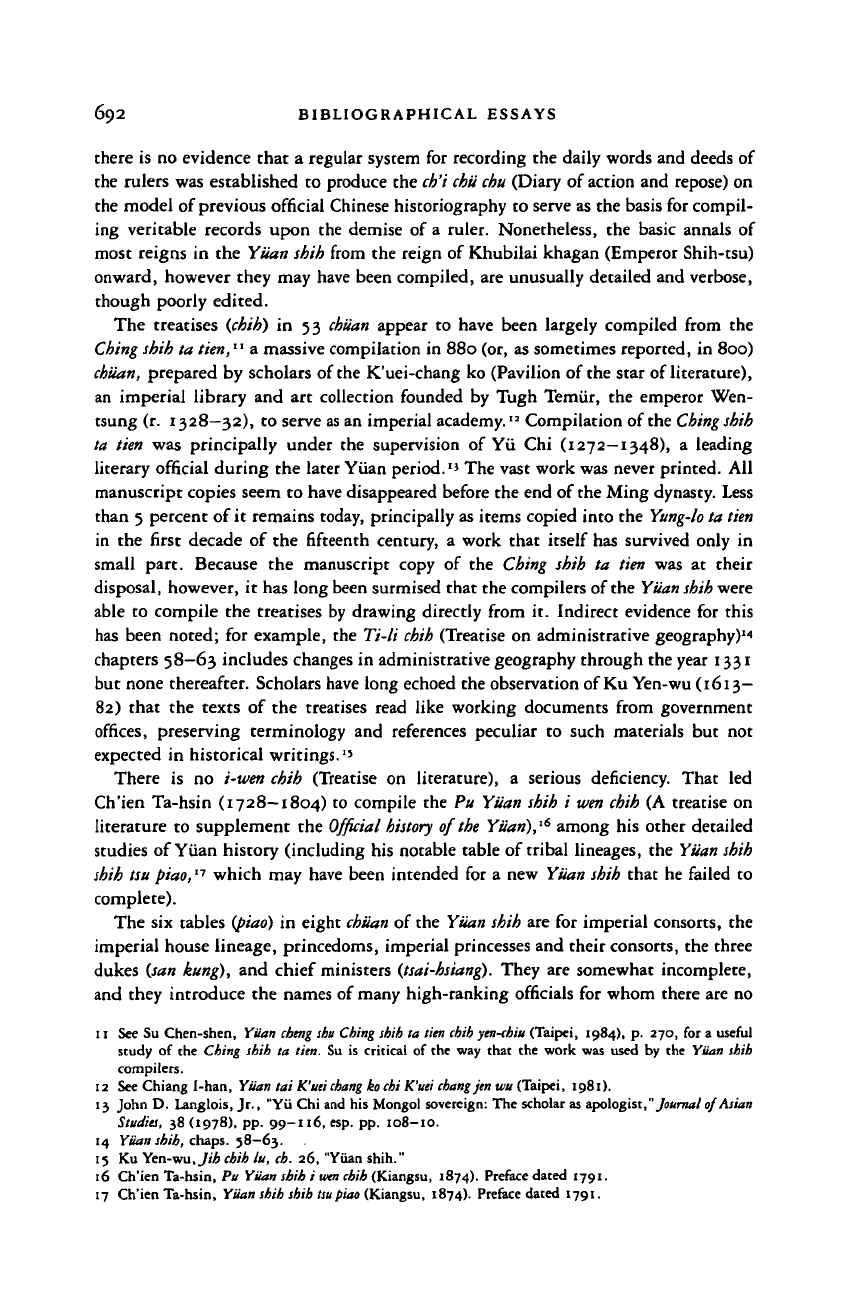
692 BIBLIOGRAPHICAL ESSAYS
there is no evidence that a regular system for recording the daily words and deeds of
the rulers was established to produce the
ch'i chii chu
(Diary of action and repose) on
the model of previous official Chinese historiography to serve as the basis for compil-
ing veritable records upon the demise of a ruler. Nonetheless, the basic annals of
most reigns in the Yiian
shih
from the reign of Khubilai khagan (Emperor Shih-tsu)
onward, however they may have been compiled, are unusually detailed and verbose,
though poorly edited.
The treatises (chih) in 53
chiian
appear to have been largely compiled from the
Ching shih
ta tien," a massive compilation in 880 (or, as sometimes reported, in 800)
chiian,
prepared by scholars of
the
K'uei-chang ko (Pavilion of the star of literature),
an imperial library and art collection founded by Tugh Temiir, the emperor Wen-
tsung (r. 1328—32), to serve
as
an imperial academy." Compilation of the
Ching shih
ta tien was principally under the supervision of Yu Chi (1272—1348), a leading
literary official during the later Yuan period.'
3
The vast work was never printed. All
manuscript copies seem to have disappeared before the end of the Ming dynasty. Less
than 5 percent of it remains today, principally as items copied into the
Yung-lo
ta
tien
in the first decade of the fifteenth century, a work that itself has survived only in
small part. Because the manuscript copy of the Ching shih ta tien was at their
disposal, however, it has long been surmised that the compilers of
the Yuan shih
were
able to compile the treatises by drawing directly from it. Indirect evidence for this
has been noted; for example, the Ti-li
chih
(Treatise on administrative geography)
14
chapters 58-63 includes changes in administrative geography through the year 1331
but none thereafter. Scholars have long echoed the observation of
Ku
Yen-wu
(1613—
82) that the texts of the treatises read like working documents from government
offices, preserving terminology and references peculiar to such materials but not
expected in historical writings.'
5
There is no
i-wen
chih
(Treatise on literature), a serious deficiency. That led
Ch'ien Ta-hsin (1728—1804) to compile the Pu Yuan
shih
i
wen chih
(A treatise on
literature to supplement the
Official history
of
the
Yiian),
16
among his other detailed
studies of Yiian history (including his notable table of tribal lineages, the
Yiian shih
shih tsu
piao,
'
7
which may have been intended for a new
Yiian shih
that he failed to
complete).
The six tables
(piao)
in eight
chiian
of the
Yiian shih
are for imperial consorts, the
imperial house lineage, princedoms, imperial princesses and their consorts, the three
dukes
(san
kung), and chief ministers
(tsai-hsiang).
They are somewhat incomplete,
and they introduce the names of many high-ranking officials for whom there are no
11 See Su Chen-shen, Yiian chtng
shu
Ching shih ta tien
chih
yen-cbiu (Taipei, 19S4), p. 270, for a useful
study of the Ching shih ta tien. Su is critical of the way that the work was used by the Yiian shih
compilers.
12 See Chiang I-han, Yuan tai K'uei
chang
ko chi K'uei changjen wu (Taipei, 1981).
13 John D. Langlois, Jr., "Yu Chi and his Mongol sovereign: The scholar as apologist,"Journal
0/Asian
Studies, 38(1978), pp. 99—116, esp. pp. 108-10.
[4 Yiian shih, chaps. 58—63.
15 Ku Yen-wu, Jih chih lu, ch. 26, "Yiian shih."
16 Ch'ien Ta-hsin, Pu Yiian shih i
wen
chih (Kiangsu, 1874). Preface dated 1791.
17 Ch'ien Ta-hsin, Yiian shih shih
tsu
piao (Kiangsu, 1874). Preface dated 1791.
Cambridge Histories Online © Cambridge University Press, 2008
